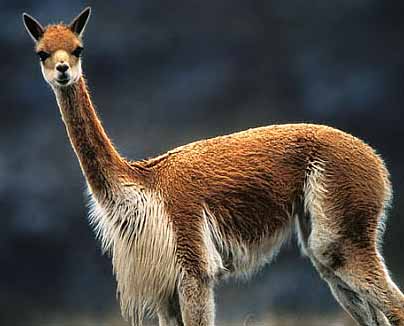Vicuña
Vicuna in Northern Chile
The vicuña ( Vicugna vicugna ) is next to the alpaca one of the two species of the genus Vicugna and belongs to the camelid family. It is similar to the guanaco but smaller and slimmer.
Characteristics, distribution, behavior
Its body length is 150 cm, shoulder height 100 cm, weight 50 kg. It is light brown on the upper side and lower side whitish. A special feature of the lower incisors that continually grow as in rodents - there is nothing comparable not cloven.
The coat is much finer than the related species and so dense that it acts as an insulating layer against the cold.
Widespread is the vicuna in the high Andes of Ecuador, Peru, Bolivia, Argentina and Chile. It occurs here at altitudes 3500-5500 meters.
As the guanaco lives the vicuña in territorial family groups that are led by a respective male. There are also bachelor troops ( males who are still able to defend a territory because of their young age ) and solitary old males ( who have been displaced by younger males by their associations ).
Domestication
The classical school of thought was once that the vicuña was never domesticated and descended that llama and alpaca from the guanaco. Today, however, there is DNA examination findings that suggest that the alpaca could be descended from the vicuña. Since alpacas, llamas, guanacos and vicuña are mutually fruitful, and the lines are often mixed together, the origin of the domestic forms can no longer reproduce with certainty today. It is certain that the Inca Vikunjas exaggeration to tens of thousands in gates whose wool sheared for exclusive use by high nobles and the animals then releasing them again. The Spaniards continued this tradition discontinued. They shot from vicuña in large numbers and often poisoned their water points, first to make room for pastures and later because of the fur. The wool of the vicuna is considered the rarest and most expensive in the world. The fashion company Falke's sweaters for around 3,400 € and stockings on for € 860 the pair of vicuña. Also fabrics are woven from the vicuña, which are processed into expensive and exclusive tailored clothing.
While there had been at the time of the Incas 1.5 million vicuña in the Andes, their number has decreased to 1965 to 6000. Since then, however, the stocks recovered rapidly as a result of protective measures, so that it reflects about 200,000 Vikunjas today. The stud book as part of the European Endangered Species Programme ( EEP) is led by Dr. Christian Schmidt from Frankfurt Zoo. The IUCN lists the vicuna now considered " not at risk ".
Taxonomy
The vicuna is often performed under the scientific name Lama vicugna, ie together with the lamas in a common genus. For a separate genre speaks the peculiarity of dentition, which differs from the other lamas. However, guanaco and vicuña are mutually fertile, which in turn suggests a very tight relationship. Therefore, the introduction of its own genus Vicugna as well as the classification of the alpacas in this genus are controversial.
Use
Vicuna are now idly held in Peru, Chile, Bolivia and Argentina for commercial use due to species protection in national parks, rare even in large enclosures. The woolly used for the production of vicuna wool of the vicuna is after the Tschiru one of the finest animal hair with a hair diameter 10-20 microns, but mostly 11 to 13.5 microns. Among the animal, only the different textile fibers and linen silk have a lower fiber diameter.
In the traditional scissors ( Chacu or Chaccu ) in Peru every two years Vikunjaherden are driven and sheared in a ceremony on funnel-shaped gate in pens. Here, a wool having an average fiber length of 2 - 4 cm obtained. The weight of shorn wool hair is about 150 g per animal, after the removal of unwanted hair from the deck woolly remain a few ounces, which accounts for about 7 - traded 15 euros per ounce. While the hair of the belly area forms a smaller part, which is much brighter and correspondingly higher prices achieved since the hair structure of the vicuna suffers from a bleaching or dyeing.










